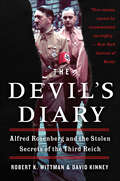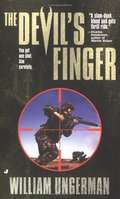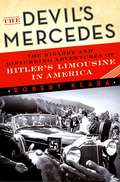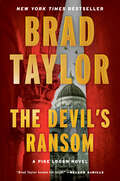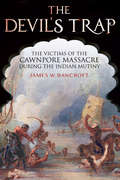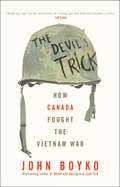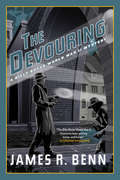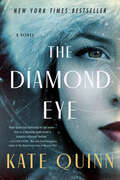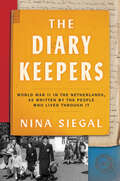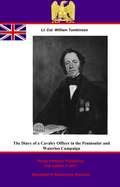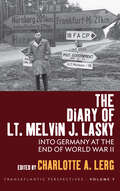- Table View
- List View
The Devil's Captain: Ernst Jünger in Nazi Paris, 1941-1944
by Allan MitchellAuthor of Nazi Paris, a Choice Academic Book of the Year, Allan Mitchell has researched a companion volume concerning the acclaimed and controversial German author Ernst Jünger who, if not the greatest German writer of the twentieth century, certainly was the most controversial. His service as a military officer during the occupation of Paris, where his principal duty was to mingle with French intellectuals such as Jean Cocteau and with visiting German celebrities like Martin Heidegger, was at the center of disputes concerning his career. Spending more than three years in the French capital, he regularly recorded in a journal revealing impressions of Parisian life and also managed to establish various meaningful social contacts, with the intriguing Sophie Ravoux for one. By focusing on this episode, the most important of Jünger's adult life, the author brings to bear a wide reading of journals and correspondence to reveal Jünger's professional and personal experience in wartime and thereafter. This new perspective on the war years adds significantly to our understanding of France's darkest hour.
The Devil's Castle: Nazi Eugenics, Euthanasia, and How Psychiatry's Troubled History Reverberates Today
by Susanne Paola AntonettaThe Devil&’s Castle delves into the forgotten history of eugenics and links it to present-day psychiatry to explain how we as a culture continue to get mind care so wrongIn The Devil&’s Castle, Susanne Paola Antonetta weaves a haunting narrative that confronts the darkest chapters of psychiatric history while offering a bold vision for the future of mental health care. In 1939, the eugenics movement growing throughout the West did its worst in Nazi Germany. Through the Aktion T4 euthanasia program, five asylums and an abandoned jail were transformed into gas chambers. Tens of thousands of lives—predominantly adults with neuropsychiatric conditions—were extinguished in those structures, ultimately paving the way for the horrors of the Holocaust.Interlacing her experiences of psychosis with the complex history of psychiatry, Antonetta sheds light on the intersections of madness and societal perceptions of mental difference. She brings to life the stories of Paul Schreber and Dorothea Buck, two historical figures who act as models for mind care and acceptance.This gripping exploration traverses the spectrum of neurodiversity, from the devastating consequences of dehumanization to the transformative potential of understanding and acceptance. With The Devil&’s Castle, Antonetta not only unearths the failures of our past, but also envisions a more compassionate, enlightened approach to consciousness and mental health care. This is a story of tragedy, resilience, and hope—a rallying cry for change that dares to challenge the limits of how we define and support the human mind.
The Devil's Chariots: The origins and secret battles of tanks in the First World War
by John GlanfieldThe Devil's Chariots is the product of six years of research by author John Glanfield, who wanted to tell the story of the birth of the tank in World War I, and, importantly, the men behind it. Based on personal recollections and official reports, Glanfield uncovers the British tank pioneers and their odd machines, the men who supported the new weapon, those who refused to accept their worth, and the brave crews who took them into battle. The birth of the tank is a story of bitter conflicts between visionaries, politicians and the military, set against the backdrop of a brutal war. The clash of personalities and prejudices under the pressures of war and competition for materials resulted in disastrous delays and often bizarrely naive experimental machines, which nevertheless ultimately led to triumph on the battlefield.The Devil's Chariots charts the initial experiments and tests that eventually led to the now-familiar design, which, in turn, went on to revolutionize warfare.
The Devil's Diary: Alfred Rosenberg and the Stolen Secrets of the Third Reich
by Robert K. Wittman David KinneyThe Devil&’s Diary is the true account of the disappearance of Alfred Rosenberg&’s journal of Nazi ideology that shaped the genesis of the Holocaust. An influential figure in Adolf Hitler&’s early inner circle, Alfred Rosenberg made his name spreading toxic ideas about the Jews throughout Germany, publishing a bestselling masterwork of Nazi thinking at the dawn of the Third Reich. His diary was discovered hidden in a Bavarian castle at war&’s end—five hundred pages providing a harrowing glimpse of the man whose ideas set the stage for the Holocaust. Prosecutors examined it during the Nuremberg war crimes trial, but after Rosenberg was convicted, sentenced, and executed, it mysteriously vanished. New York Times bestselling author Robert K. Wittman, who as an FBI agent and private consultant specialized in recovering artifacts of historic significance, learned of the diary when the U.S. Holocaust Memorial Museum&’s chief archivist informed him that someone was trying to sell it for upwards of a million dollars. A decade-long hunt led them to many people who handled and hid the book. From the crusading Nuremberg prosecutor who smuggled the diary out of Germany to the man who finally turned it over, everyone had reasons for hiding the truth. Drawing on Rosenberg&’s entries about his role in the seizure of priceless artwork and the brutal occupation of the Soviet Union, his conversations with Hitler and his rivalries with Göring, Goebbels, and Himmler, Wittman and Pulitzer Prize-winning journalist David Kinney&’s The Devil&’s Diary offers vital historical insight of unprecedented scope into the innermost workings of the Nazi regime—and into the psyche of the man whose radical vision mutated into the Final Solution.
The Devil's Doctors: Japanese Human Experiments on Allied Prisoners of War
by Mark FeltonThe author of Guarding Hitler delivers &“a study revealing the Japanese use of Allied POWs in medical experiments during WWII.&”—The Guardian The brutal Japanese treatment of Allied POWs in WW2 has been well documented. The experiences of British, Australian and American POWs on the Burma Railway, in the mines of Formosa and in camps across the Far East, were bad enough. But the mistreatment of those used as guinea pigs in medical experiments was in a different league. The author reveals distressing evidence of Unit 731 experiments involving US prisoners and the use of British as control groups in Northern China, Hainau Island, New Guinea and in Japan. These resulted in loss of life and extreme suffering. Perhaps equally shocking is the documentary evidence of British Government use of the results of these experiments at Porton Down in the Cold War era in concert with the US who had captured Unit 731 scientists and protected them from war crime prosecution in return for their cooperation. The author&’s in-depth research reveals that, not surprisingly, archives have been combed of much incriminating material but enough remains to paint a thoroughly disturbing story. &“The narrative does not seek sensation or attempt to draw irrefutable conclusions where it is clearly impossible to do so, instead it simply provides a balanced assessment of what is known and what seems probable.&”—Pegasus Archive
The Devil's Finger
by William S. UngermanMyles Rawlings and Lon Grainger are hunters of men. Trained snipers, they have demonstrated their mastery of the one-shot kill on every corner of the globe. But their new contract takes them to the remote hell of Zapata, Texas--where a vicious drug lord terrorizes and kills all who oppose him. But what begins as just another job becomes a personal mission of redemption and vengeance as Rawlings and Grainger fight to catch the drug kingpin in their crosshairs--while they themselves are being hunted by the bloody demons of their past.
The Devil's Garden: Rommel's Desperate Defense of Omaha Beach on D-Day
by Steven ZalogaA military historian&’s account of the German fortifications at Omaha Beach explains the huge American losses during this key WWII conflict. In this fresh look at D-Day—one of World War II's pivotal battles—author Steven Zaloga draws on original research, including recently discovered German artillery maps, and offers well-supported evidence for why the U.S. Army suffered such enormous casualties on Omaha Beach. Focusing on Erwin Rommel, the Desert Fox, who oversaw German defenses in Normandy, Zaloga covers little-known aspects of the war, such as the German patrols who were tasked with shooting down pigeons the French resistance used to send messages to the Allies, offering up conclusions that are sure to spark debate.
The Devil's Gardens: The Story of Landmines
by Lydia Monin'The image I have is a kid on a country lane on a Saturday afternoon herding his family cattle, meaning no harm to anybody and putting one step wrong. It's one thing to die in combat, it's one thing to die defending land, but it's another thing to die tending cattle on a Saturday afternoon and we want a world where that doesn't happen' - Michael IgnatieffDuring the twentieth century a landmine plague raged across the globe. It began on the battlefields of two world wars, it gathered momentum in Korea and Vietnam and then spread like wildfire throughout the developing world. The Devil's Gardens is the definitive story of the landmine. It is the story of the development and proliferation of a weapon of terror. It is also the story of suffering and devastation, and a worldwide crusade to put an end to the curse of landmines forever. The issues surrounding landmines and their continued use are controversial. Drawing on a wide range of distinguished interviewees and the authors' first-hand experiences in severely mine-affected countries, The Devil's Gardens look at all sides of the landmine story.
The Devil's Hand: James Reece 4 (Terminal List #4)
by Jack CarrNEW YORK TIMES AND USA TODAY BESTSELLING AUTHORThe fourth thriller in the &“so powerful, so pulse-pounding, so well-written&” (Brad Thor, #1 New York Times bestselling author) Terminal List series follows former Navy SEAL James Reece as he is entrusted with a top-secret CIA mission of retribution twenty years in the making. It&’s been twenty years since 9/11. Two decades since the United States was attacked on home soil and embarked on twenty years of war. The enemy has been patient, learning, and adapting. And the enemy is ready to strike again. A new president offers hope to a country weary of conflict. He&’s a young, popular, self-made visionary…but he&’s also a man with a secret. Halfway across the globe a regional superpower struggles with sanctions imposed by the Great Satan and her European allies, a country whose ancient religion spawned a group of ruthless assassins. Faced with internal dissent and extrajudicial targeted killings by the United States and Israel, the Supreme Leader puts a plan in motion to defeat the most powerful nation on earth. Meanwhile, in a classified facility five stories underground, a young PhD student has gained access to a level of bioweapons known only to a select number of officials. A second-generation agent, he has been assigned a mission that will bring his adopted homeland to its knees. With Jack Carr&’s signature &“absolutely intense&” (Chuck Norris) writing and &“gripping authenticity&” (The Real Book Spy), The Devil&’s Hand is a riveting and timely thriller that will leave you gasping for breath.
The Devil's Hand: the GRIPPING James Reece thriller now on Amazon Prime (Terminal List Ser. #4)
by Jack Carr**THE NEW YORK TIMES BESTSELLER – NOW AN AMAZON PRIME TV SERIES STARRING CHRIS PRATT** If you loved Lee Child's Jack Reacher, Peter James's Roy Grace or Michael Connelly's Mickey Haller, you will love The Devil's Hand and the James Reece series!'Take my word for it, James Reece is one rowdy motherf***er. Get ready!' Chris Pratt 'This is seriously good . . . the suspense is unrelenting, and the tradecraft is so authentic the government will probably ban it –so read it while you can!' Lee Child 'With a particular line in authentic tradecraft, this fabulously unrelenting thrill-ride was a struggle to put down' Mark DawsonIt has been two decades since 9/11. The enemy has been patient. The enemy has been learning. The enemy has been adapting. The enemy is ready to strike again . . . Former Navy SEAL James Reece must embark on a top-secret CIA mission of retribution twenty years in the making in this riveting and timely thriller that will leave you gasping for breath.Praise for Jack Carr . . . 'Gritty, raw and brilliant!' Tom Marcus &‘So powerful, so pulse-pounding, so well-written – rarely do you read a debut novel this damn good&’ Brad Thor 'Carr writes both from the gut and a seemingly infinite reservoir of knowledge in the methods of human combat. Loved it!' Chris Hauty 'A powerful, thoughtful, realistic, at times terrifying thriller that I could not put down. A terrific addition to the genre, Jack Carr and his alter-ego protagonist, James Reece, continue to blow me away' Mark Greaney 'Thrilling' Publishers Weekly
The Devil's Mercedes: The Bizarre and Disturbing Adventures of Hitler's Limousine in America
by Robert KlaraIn 1938, Mercedes-Benz began production of the largest, most luxurious limousine in the world. A machine of frightening power and sinister beauty, the Grosser 770K Model W150 Offener Tourenwagen was 20 feet long, seven feet wide, and tipped the scales at 5 tons. Its supercharged, 230-horsepower engine propelled the beast to speeds over 100 m.p.h. while its occupants reclined on glove-leather seats stuffed with goose down. Armor plated and equipped with hidden compartments for Luger pistols, the 770K was a sumptuous monster with a monstrous patron: Adolph Hitler and the Nazi party. Deployed mainly for propaganda purposes before the war, the hand-built limousines--in which Hitler rode standing in the front seat--motored through elaborate rallies and appeared in countless newsreels, swiftly becoming the Nazi party's most durable symbol of wealth and power. Had Hitler not so thoroughly dominated the scene with his own megalomania, his opulent limousine could easily have eclipsed him. Most of the 770Ks didn't make it out of the rubble of World War II. But several of them did. And two of them found their way, secretly and separately, to the United States. Author Robert Klara uncovers the forgotten story of how Americans responded to these rolling relics of fascism on their soil. The limousines made headlines, drew crowds, made fortunes and ruined lives. What never became public was how both of the cars would ultimately become tangled in a web of confusion, mania, and opportunism, fully entwined in a story of mistaken identity. Nobody knew that the limousine touted as Hitler's had in fact never belonged to him, while the Mercedes shrugged off as an ordinary staff car--one later abandoned in a warehouse and sold off as government surplus--turned out to be none other than Hitler's personal automobile. It would take 40 years, a cast of carnies and millionaires, the United States Army, and the sleuthing efforts of an obscure Canadian librarian to bring the entire truth to light.
The Devil's Playground: Inside America's Defense of the Deadly Korean DMZ
by Gary L. BloomfieldThe Devil's Playground is a timely account of what it is like to serve along perhaps the most dangerous and sensitive strip of land in the world. In recent months two bullet-riddled attempted escapes from North to South brought worldwide headlines. And with Donald Trump and Kim Jong-un exchanging threats, the world hopes for a diplomatic solution, but watches with bated breath. Author Gary L. Bloomfield, a military journalist in what is called &“the demilitarized&” zone between North and South Korea in the 1970s, combines his personal experience with interviews and historical insights to present a fresh, up-to-date, account of what it is like to serve on perhaps the most contentious strip of land in the world today. The Devil&’s Playground combines history with current events that today have the rest of the world watching, hoping there is no explosion, which could lead to a nuclear war. While world attention is focused on the Koreas, few people understand what is at stake and what happens there every day. Here is the unfiltered answer. Formed in 1953 after the Korean War ended in a stalemate, the demilitarized zone is anything but. It is in fact one of the most heavily-armed regions in the world--a powder keg just waiting for someone to light the fuse. There have been more than 40,000 truce violations ranging from minor fisticuffs to brutal killings, from moving heavy artillery into the zone to assassination attempts in downtown Seoul since the Armistice Agreement was signed. The demilitarized zone is also the focus of an intense propaganda war—with thousands of flyers sent across the border each year from both sides. Few people realize that over the years North Korea has trained 100,000 men for guerrilla warfare across the border, and it is unknown how many have already secreted themselves in South Korea. It is the duty of the American and South Korean soldiers there to stop them. Gary Bloomfield presents here the first unvarnished accounts of the tension and the impact serving on the line can bring. Just one example: Though firefights are rare, US soldiers often hear North Korean soldiers and their laughter and the taunts, but they rarely see their tormentors. Life along the demilitarized zone is a war of nerves, a game of cat and mouse, though it&’s hard to tell who&’s chasing whom. Bloomfield covers it all in unsparing detail and offers fascinating previously little-known details. Life along the demilitarized zone is a war of nerves, a game of cat and mouse, though it&’s hard to tell who&’s chasing whom. Bloomfield covers it all in unsparing detail and offers fascinating details. Here is Guardpost Ouellette, which some American soldiers call the edge of the world; or Radar Site #4, overlooking the truce village of PanMunJom to the west, a hilltop where the tension is thick 24 hours a day; deadly minefields and miles of razor-sharp concertina wire and the desperate people who try of pass over them. Here also are the trigger-happy, shoot-to-kill sentries along the border on both sides; concrete bunkers with 24-hour guards armed with machine-guns, and spotlights, trip flares and other sensing devices concealed everywhere add to the heavily-fortified barrier against a North Korean attack. And of course the details of the Tree Incident in 1976, which nearly triggered World War III. The Devil's Playground is a living history with the spit of real life and a vivid look at brinksmanship in its most precarious state.
The Devil's Ransom: A Pike Logan Novel (Pike Logan #17)
by Brad TaylorIn the latest explosive thriller from New York Times bestselling author and former special forces officer Brad Taylor, Pike Logan races to stop an insidious attack orchestrated by a man who knows America’s most treasured secrets. Conducting a routine cover development trip to Tajikistan, Pike and Jennifer learn that Afghanistan has fallen, and there’s a man on the run. One that has done more for the United States in Afghanistan than anyone else. Pulled in to extract him, Pike collides headlong into a broader mystery: His covert company, along with every other entity in the Taskforce, has been hit with a ransomware attack, and there’s some connection between the Taliban and the hack. Given the order to track down the perpetrators, he has no idea that the problem set is much, much larger and more dangerous than a simple attack on his organization. That hack was just a test-run, and the real one is coming soon, engendered by a former NSA specialist in the U.S. government. A man who wants to return to the bipolar world of the Cold War, the turncoat has cloaked his attack behind hackers from Serbia and Russia, and if successful, his target will alter the balance of power on the global stage. So far, the specialist has remained one step ahead of the Taskforce, but he has just made one massive mistake: hitting Pike Logan.
The Devil's Right Hand
by J. D. RhoadesThe critically-acclaimed debut novel by J. D. Rhoades, and the introduction of iconic bounty hunter Jack Keller. Keller is a man tormented by the nightmares he's had ever since a disastrous tour in Desert Storm. Destroyed by his experience, Keller now makes his living tracking bailjumpers for H&H, a North Carolina bail bonds company run by a reclusive, beautiful, and horribly scarred woman named Angela. In truth, Keller doesn't work bail enforcement to live, he lives to work: the only thing that breaks through the numbness is the thrill of the hunt, the sound of gunfire, the high that comes with each successful takedown. When H&H is required to track down a lifelong loser for jumping bail on a routine burglary collar, Keller has no idea how gravely events are about to spiral out of his control. He chases his quarry straight into the center of a firestorm involving a pair of local Indians blinded by rage and hell-bent to avenge their father's murder. Along the way they encounter a vicious North Carolina cop with a mean streak and very few moral boundaries. Not to mention the cop's beautiful partner Marie, caught between a newfound desire for the just-on-the-edge-of-the-law Jack Keller and her loyalty to a police department with a serious ethics problem. These people, each hurtling forward on their own individual trajectories of self-destruction, begin to intersect each other's lives in a series of volatile, escalating, and deadly events. Furiously paced and filled with unforgettable, masterfully drawn characters destined to meet in a bloody showdown which most of them will not survive, The Devil's Right Hand is a stylish, razor-edged debut novel that redefines the rules of the Southern thriller.
The Devil's Trap: The Victims of the Cawnpore Massacre During the Indian Mutiny
by James W. BancroftThis history of the Siege of Cawnpore and the massacre of British noncombatants in Colonial India reveals the human side of the struggle.During the Indian Rebellion of 1857, the strategic garrison at Cawnpore was surprised by an extended siege. Many British noncombatants were holed up in a makeshift entrenchment, suffering from thirst, starvation and disease, all while being bombarded with cannon balls and bullets. After nearly two months, the company surrendered to the rebel leader Nana Sahib in exchange for safe passage out of the city. But when the survivors reached Sati Chaura Ghat, a landing on the River Ganges, they were massacred.Much has been written about the siege of Cawnpore and the political events which caused it, but there less known about the people who suffered the ordeal. In The Devil’s Trap, historian James Bancroft studies official documentation and primary sources from both sides to offer a more human understanding of events and shed light on the lives of the victims.
The Devil's Trick: How Canada Fought the Vietnam War
by John BoykoMore than forty-five years after the fall of Saigon, John Boyko brings to light the little-known story of Canada's involvement in the American War in Vietnam.Through the lens of six remarkable people, some well-known, others obscure, bestselling historian John Boyko recounts Canada's often-overlooked involvement in that conflict as peacemaker, combatant, and provider of weapons and sanctuary. When Brigadier General Sherwood Lett arrived in Vietnam over a decade before American troops, he and the Canadians under his command risked their lives trying to enforce an unstable peace while questioning whether they were merely handmaidens to a new war. As American battleships steamed across the Pacific, Canadian diplomat Blair Seaborn was meeting secretly in Hanoi with North Vietnam's prime minister; if American leaders accepted his roadmap to peace, those ships could be turned around before war began. Claire Culhane worked in a Canadian hospital in Vietnam and then returned home to implore Canadians to stop supporting what she deemed an immoral war. Joe Erickson was among 30,000 young Americans who changed Canada by evading the draft and heading north; Doug Carey was among 20,000 Canadians who enlisted with the American forces to serve in Vietnam. Rebecca Trinh and her family fled Saigon and joined the waves of desperate Indochinese refugees, thousands of whom forged new lives in Canada. Through these wide-ranging and fascinating accounts, Boyko exposes what he calls the Devil's wiliest trick: convincing leaders that war is desirable, the public that it's acceptable and combatants that what they are doing and seeing is normal, or at least necessary. In uncovering Canada's side of the story, he reveals the many secret and forgotten ways that Canada not only fought the war but was shaped by its lessons and lies.
The Devils Will Get No Rest: FDR, Churchill, and the Plan That Won the War
by James B. ConroyWritten with &“a cinematic sense of urgency and realism&” (Evan Osnos, National Book Award–winning author), this is the first full account of the Casablanca Conference of January 1943, the secret ten-day parlay in Morocco where FDR, Churchill, and their divided high command hammered out a winning strategy at the tipping point of World War II.The Devils Will Get No Rest is a &“vivid and engaging&” (Jon Meacham, Pulitzer Prize–winning author) character-driven account of the Casablanca Conference of January 1943, an Anglo-American clash over military strategy that produced a winning plan when World War II could have gone either way. Churchill called it the most important Allied conclave of the war. Until now, it has never been explored in a full-length book. In a secret, no-holds-barred, ten-day debate in a Moroccan warzone, protected by British marines and elite American troops, Franklin Roosevelt, Winston Churchill, Charles de Gaulle, George C. Marshall, Dwight D. Eisenhower, George S. Patton Jr., Sir Alan Brooke, Lord Louis Mountbatten, Sir Harold Alexander, and their military peers questioned each other&’s competence, doubted each other&’s visions, and argued their way through choices that could win or lose the war. You will be treated to a master class in strategy by the legendary statesmen, generals, and admirals who overcame their differences, transformed their alliance from a necessity to a bond, forged a war-winning plan, and glimpsed the postwar world.
The Devils' Alliance: Hitler's Pact with Stalin, 1939-1941
by Roger MoorhouseHistory remembers the Soviets and the Nazis as bitter enemies and ideological rivals, the two mammoth and opposing totalitarian regimes of World War II whose conflict would be the defining and deciding clash of the war. Yet for nearly a third of the conflict’s entire timespan, Hitler and Stalin stood side by side as allies. In The Devils’ Alliance, acclaimed historian Roger Moorhouse explores the causes and implications of the tenuous Nazi-Soviet pact, an unholy covenant whose creation and dissolution were crucial turning points in World War II. Indeed, this riveting chapter of World War II is the key to understanding why the conflict evolved--and ended--the way it did. Nazism and Bolshevism made unlikely bedfellows, but the brutally efficient joint Nazi-Soviet invasion of Poland in 1939 illustrated the powerful incentives that existed for both sides to set aside their differences. Forged by vain and pompous German foreign minister Joachim von Ribbentrop and his Russian counterpart, the inscrutable and stubborn Vyacheslav Molotov, the Nazi-Soviet pact in August of 1939 briefly unified the two powers. Together, the Germans and Soviets quickly conquered and divvied up central and eastern Europe-- Poland, the Baltic States, Finland, and Bessarabia--aiding one another through exchanges of information, blueprints, and prisoners. The human cost was staggering: in Poland alone, the Soviets deported 1. 5 million people in 1940, 400,000 of whom would never return. Tens of thousands were also deported from the Baltic States, including almost all of the members of the Estonian parliament. Of the 100,000 civilians deported to Siberia from Bessarabia, barely a third survived. Nazi and Soviet leaders hoped that a similar quid-pro-quo agreement would also characterize their economic relationship. The Soviet Union would export much-needed raw materials to Germany, while the Germans would provide weapons and technological innovations to their communist counterparts. In reality, however, economic negotiations were fraught from the start, not least because the Soviets, mindful that the Germans were in dire need of raw materials to offset a British blockade, made impossible demands of their ally. Although German-Soviet trade still grew impressively through 1940, it was not enough to convince Hitler that he could rely on the partnership with Moscow, which on the whole was increasingly turbulent and unpredictable. Fortunately for the Allies, the pact--which seemed to negate any chances of an Allied victory in Europe--was short-lived. Delving into the motivations and forces at work, Moorhouse explores how the partnership soured, ultimately resulting in the surprise June 1941 German invasion of the Soviet Union. With the final dissolution of the pact, the Soviets sided with the Western democracies, a development that changed the course of the war--and which, upon Germany’s defeat, allowed the Soviets to solidify the inroads they had made into Eastern Europe during their ill-starred alliance. Reviled by contemporaries, the Nazi-Soviet Pact would have a similarly baleful afterlife. Though it was torn up by the Nazis and denied or excused as a strategic necessity by the Soviets, its effects and political ramifications proved remarkably persistent. The boundaries of modern eastern and central Europe adhere closely to the hasty divisions made by Ribbentrop and Molotov. Even more importantly, the pact laid the groundwork for Soviet control of Eastern Europe, a power grab that would define the post-war order. Drawing on memoirs, diaries, and official records from newly opened Soviet archives, The Devils’ Alliance is the authoritative work on one of the seminal episodes of World War II. In his characteristically rich and detailed prose, Moorhouse paints a vivid picture of the pact’s origins and its enduring influence as a crucial turning point, in both the war and in modern history.
The Devouring
by James R. BennA murder in wartime Switzerland reveals Swiss complicity with the Nazis in World War II, and US Army detective Billy Boyle is called to investigate.Europe, 1944: Captain Billy Boyle and his friend Lieutenant Piotr “Kaz” Kazimierz are sent to neutral Switzerland to work with the Office of Strategic Services (OSS), investigating Swiss banks that are laundering looted Nazi gold. The US and Swiss governments are about to embark on diplomatic discussions regarding the Safehaven Protocols, aimed at limiting the amount of war materials exported by Switzerland to the Nazis, stemming the tide of looted gold, and preventing postwar use of Nazi wealth by war criminals. With the talks about to begin and the Gestapo ever present, the OSS wants Billy and Kaz to protect the participants, which turns out to be a very deadly task.The plans go wrong from the beginning when Billy and Kaz crashland in France. As they make their way through occupied territory to the border, they meet Anton Lasho, a member of the Sinti ethnic group, whose family was slaughtered by the Nazis, and who is, in turn, a one-man Nazi-killing machine. They’ll need his help, because as they find once they make it across the border, Swiss banks are openly laundering gold “harvested” from concentration camps, and those who are profiting will do everything they can to protect their wealth and hide their dark secrets.
The Diamond Eye: A Novel
by Kate QuinnDon’t miss the thrilling new novel from Kate Quinn, The Briar Club, coming July 9th! New York Times BestsellerThe bestselling author of The Rose Code returns with an unforgettable World War II tale of a quiet bookworm who becomes history’s deadliest female sniper. Based on a true story.In 1937 in the snowbound city of Kyiv, wry and bookish history student Mila Pavlichenko organizes her life around her library job and her young son—but Hitler’s invasion of Ukraine and Russia sends her on a different path. Given a rifle and sent to join the fight, Mila must forge herself from studious girl to deadly sniper—a lethal hunter of Nazis known as Lady Death. When news of her three hundredth kill makes her a national heroine, Mila finds herself torn from the bloody battlefields of the eastern front and sent to America on a goodwill tour.Still reeling from war wounds and devastated by loss, Mila finds herself isolated and lonely in the glittering world of Washington, DC—until an unexpected friendship with First Lady Eleanor Roosevelt and an even more unexpected connection with a silent fellow sniper offer the possibility of happiness.But when an old enemy from Mila’s past joins forces with a deadly new foe lurking in the shadows, Lady Death finds herself battling her own demons and enemy bullets in the deadliest duel of her life.Based on a true story, The Diamond Eye is a haunting novel of heroism born of desperation, of a mother who became a soldier, of a woman who found her place in the world and changed the course of history forever.
The Diaries of Lady Anne Clifford
by D.J.H CliffordNoblewoman, vividly documents both the great and the trivial events of her long life. They cover her life from her childhood days, when she witnessed the funeral of Queen Elizabeth I, to her last months, when she recalled her past from her room in Brougham Castle. Through compiling and transcribing the manuscript records, D.J.H. Clifford here presents in one volume the full range of Lady Anne's life: her active role at court as the Countess of Dorset (residing at Knole in Kent), her turbulent second marriage to the 4th Earl of Pembroke at Wilton Wiltshire, and her final, long-disputed succession to her father's lands in Westmorland and North Yorkshire. The diaries are complemented by explanatory notes, family trees and illustrations. They provide both an important historical record and an intriguing glimpse into the and character of this noble and Christian lady, whose powerful presence is still in evidence today in the monuments and folklore of Westmorland.
The Diary And Letters Of A World War 1 Fighter Pilot
by Christopher M. BurgessThis is a first-hand account of the authors grandfather, Guy Mainwaring Knocker and his experiences as a pilot in the R.F.C. in the First World War written as a series of letters and diary entries. He wrote letters virtually every day to his family, while he trained in England and was in service in France, and often illustrated them with little sketches. Guy was a gifted artist, particularly pencil and Pen & ink, and also an excellent photographer. He flew with No 65 (Fighter) Squadron that was formed in June, 1916 as a fighter squadron, and flew to France in March 1917 in time to play a prominent part in the air operations during the Battles of Arras. In June 1917, the squadron moved to Calais for special patrol work in the Dover Straits area, to intercept enemy aircraft raiding England.
The Diary Keepers: World War II in the Netherlands, as Written by the People Who Lived Through It
by Nina SiegalA riveting look at the story of World War II and the Holocaust through the diaries of Dutch citizens, firsthand accounts of ordinary people living through extraordinary times Based on select writings from a collection of more than two thousand Dutch diaries written during World War II in order to record this unparalleled time, and maintained by devoted archivists, The Diary Keepers illuminates a part of history we haven’t seen in quite this way before, from the stories of a Nazi sympathizing police officer to a Jewish journalist who documented daily activities at a transport camp.Journalist Nina Siegal, who grew up in a family that had survived the Holocaust in Europe, had always wondered about the experience of regular people during World War II. She had heard stories of the war as a child and Anne Frank’s diary, but the tales were either crafted as moral lessons — to never waste food, to be grateful for all you receive, to hide your silver — or told with a punch line. The details of the past went untold in an effort to make it easier assimilate into American life.When Siegal moved to Amsterdam as an adult, those questions came up again, as did another horrifying one: Why did seventy five percent of the Dutch Jewish community perish in the war, while in other Western European countries the proportions were significantly lower? How did this square with the narratives of Dutch resistance she had heard so much about and in what way did it relate to the famed tolerance people in the Netherlands were always talking about? Perhaps more importantly, how could she raise a Jewish child in this country without knowing these answers?Searching and singular, The Diary Keepers mines the diaries of ordinary citizens to understand the nature of resistance, the workings of memory, and the ways we reflect on, commemorate, and re-envision the past.
The Diary Of A Cavalry Officer In The Peninsular And Waterloo Campaigns, 1809 - 1815
by Pickle Partners Publishing Rt. Hon. James Tomkinson Lieutenant-Colonel William TomkinsonThis ebook is purpose built and is proof-read and re-type set from the original to provide an outstanding experience of reflowing text for an ebook reader. Lieutenant Colonel Tomkinson's memoirs are a rarity amongst the many books written by British soldiers of their experiences during the Napoleonic period, in that it has been written by a cavalryman. This in itself makes the book interesting, but the author was also a witness to many of the pivotal engagements of the Peninsular War and Waterloo. He was present at the sieges of Badajoz, Cuidad Rodrigo, and San Sebastian, the battles of Busaco, Fuentes de Oñoro, Salamanca and Vitorria. His work is often quoted in histories of the Waterloo campaign which offers much to the casual reader or the serious historian. Perhaps most striking about Tomkinson's text is the detailed notes that he must have taken contemporaneously are melded into a flowing account of his service. The detail of the marches and orders of battle are interspersed with anecdotes and insights. Includes Linked TOC Original Text taken from the 1894 edition published by Swan Sonnenschein, London. Author - Lt.-Col William Tomkinson (1790-1872) Foreword - Rt. Hon. James Tomkinson (1840-1910) Illustrations - Numerous maps and Illustrations Annotations - Pickle Partners Publishing
The Diary of Lt. Melvin J. Lasky: Into Germany at the End of World War II (Transatlantic Perspectives #7)
by Charlotte A. LergIn 1945 Melvin J. Lasky, serving in one of the first American divisions that entered Germany after the country’s surrender, began documenting the everyday life of a defeated nation. Travelling widely across both Germany and post-war Europe, Lasky’s diary provides a captivating eye-witness account colored by ongoing socio-political debates and his personal background studying Trotskyism. The Diary of Lt. Melvin J. Lasky reproduces the diary’s vivid language as Lasky describes the ideological tensions between the East and West, as well as including critical essays on subjects ranging from Lasky’s life as a transatlantic intellectual, the role of war historians, and the diary as a literary genre.



